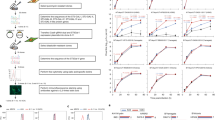Summary
By serial subculture of MDCK cells which survived high multiplicity infections with AWBY-140, a weakly cytolytic mutant of influenza virus A/WSN (H1N1), we established a variant cell line (MDCK-L cells) that was uniquely resistant to infection with influenza A and B viruses, yielding 3 to 4 orders lower amount of progeny virus compared with MDCK cells. Competitive polymerase chain reaction revealed that the amount of primary transcript produced in MDCK-L cells infected with 10 PFU/cell of influenza virus A/Aichi was suppressed to 1/100 of that in MDCK cells similarly infected, although the amount of virus adsorbed to MDCK-L cells was 1/4 of MDCK cells. Even when MDCLK-L cells were infected with 40 PFU/cell of Aichi to overcome the lower amount of internalized virus in those cells, the results were the same. The synthesis of v-, c- and mRNAs, as well as proteins of infected A/Aichi was below detectable level in MDCK-L cells, in contrast with MDCK cells, where they were clearly demonstrable by ribonuclease protection assay or polyacrylamide gel electrophoresis.
Similar content being viewed by others
References
Caliguiri LA, Holmes KV (1979) Host-dependent restriction of influenza virus maturation. Virology 92: 15–30
Chomczynski P, Sacchi N (1987) Single-step method of RNA isolation by acid guanidinium thiocyanate-phenol-chloroform extraction. Anal Biochem 162: 156–159
Fraser KB (1967) Immunofluorescence of abortive and complete infections by influenza A virus in hamster BHK21 cells and mouse L cells. J Gen Virol 1: 1–12
Gilliland G, Perrin S, Blanchard K, Bunn HF (1990) Analysis of cytokine mRNA and DNA: detection and quantitation by competitive polymerase chain reaction. Proc Natl Acad Sci USA 87: 2725–2729
Gujuluva CN, Kundu A, Murti KG, Nayak DP (1994) Abortive replication of influenza virus A/WSN/33 in HeLa299 cells: defective viral entry and budding processes. Virology 204: 491–505
Herz C, Stavnezer E, Krug RM, Gurney T Jr (1981) Influenza virus, an RNA virus, synthesizes its messenger RNA in the nucleus of infected cells. Cell 26: 391–400
Kimura Y, Yokochi T, Miyadai T, Yoshida K, Yokoo J, Matsumoto K (1985) Characterization of a porcine kidney cell line resistant to influenza virus infection. J Virol 53: 980–983
Marsh M, Bolzau E, Helenius A (1983) Penetration of Semliki forest virus from acidic prelysosomal vacuoles. Cell 32: 931–940
Martin K, Helenius A (1991) Transport of incoming influenza virus nucleocapsids into the nucleus. J Virol 65: 232–244
Nerome K, Ishida M (1978) The multiplication of influenza C virus in an established line of canine kidney (MDCK) cells. J Gen Virol 39: 179–181
Odagiri T, Tominaga K, Tobita K, Ohta S (1994) An amino acid change in the non-structural NS2 protein of an influenza A virus mutant is responsible for the generation of defective interfering (DI) particles by amplifying DI RNAs and suppressing complementary RNA synthesis. J Gen Virol 75: 43–53
Seong BL, Brownlee GG (1992) A new method for reconstituting influenza polymerase and RNA in vitro: a study of the promoter elements for cRNA and vRNA synthesis in vitro and viral rescue in vivo. Virology 186: 247–260
Shapiro GI, Gurney T Jr, Krug RM (1987) Influenza virus gene expression: control mechanisms at early and late times of infection and nuclear-cytoplasmic transport of virus-specific RNAs. J Virol 61: 764–773
Tobita K, Sugiura A, Enomoto C, Furuyama M (1975) Plaque assay and primary isolation of influenza A viruses in an established line of canine kidney cells (MDCK) in the presence of trypsin. Med Microbiol Immunol 162: 9–14
Tobita K (1975) Permanent canine kidney (MDCK) cells for isolation and plaque assay of influenza B viruses. Med Microbiol Immunol 162: 23–27
Urabe M, Tanaka T, Odagiri T, Tashiro M, Tobita K (1993) Persistence of viral genes in a variant of MDBK cell after productive replication of a mutant of influenza virus A/WSN. Arch Virol 128: 97–110
Urabe M, Tanaka T, Tobita K (1994) Use of competitive PCR to estimate the level of NS gene persisting in MDCK cells which survived productive replication of a mutant of influenza virus A/WSN. J Virol Methods 49: 361–366
Wang AM, Doyle MV, Mark DF (1989) Quantitation of mRNA by the polymerase chain reaction. Proc Natl Acad Sci USA 86: 9717–9721
Author information
Authors and Affiliations
Rights and permissions
About this article
Cite this article
Jin, H., Urabe, M. & Tobita, K. A variant of MDCK cell line which restricted growth of influenza viruses mainly through suppression of viral primary transcription. Archives of Virology 141, 923–933 (1996). https://doi.org/10.1007/BF01718166
Received:
Accepted:
Issue Date:
DOI: https://doi.org/10.1007/BF01718166




